Leiden is one of the great cities of the Netherlands. It has all of those historic and pictorial charms that you would hope for in a quaint Dutch town -- pedestrian zones, historic buildings and bicycles -- in many ways a typical Dutch place but in others, something quite special with the oldest university in the country, founded back in the mid-16th century, and lovely cafes along pretty canals in the center.
ff.jpg)
So it’s really a refreshing change to come and visit smaller cities like Leiden. This city has got the canals running through it, as do most Dutch cities, but here it’s really quite special – the canals come right into the middle of the old town and have many terrace restaurants just above the water’s edge. There are half a dozen of these very peaceful waterways, especially nice in the morning, and busy in the afternoon with lots of people out walking around shopping, eating and drinking.
ff.jpg)
Many travelers come to Amsterdam and that’s all they see, and that’s the impression they get of the country. It’s the big city, kind of crowded and moving, very much hustle-bustle. You can easily get outside of Amsterdam by train, by bus, by tour, and within 15 minutes or half an hour, you’re transported to several other small cities such as Leiden. Of course Amsterdam is a wonderful city to visit, certainly among Europe’s top 10 places to go, so very rewarding, a must for any visitor to the Netherlands. And we will bring you there later, but in this section we are taking you all around Leiden.
ff.jpg)
We will get a good look at most of the interesting parts of Leiden, enjoying a thorough walking tour down some of the main lanes, the little back lanes, side lanes, the University and its botanical gardens, along canals, exploring this town inside and out.
One of the oldest cities of the country founded about 1000 years ago but with a young population including 30,000 students among the 120,000 city residents. There are so many things for the visitor to see and do you could easily spend a couple of days here: drop in on some of its 200 restaurants, 60 bars, thousand shops, many along the pedestrian lanes, explore historic monuments such as the elaborate gatehouse through the medieval wall, one of two surviving gates from the old days, get educated and entertained at one of the half-dozen important museums and stay in one of the 22 hotels offering 3000 rooms.

The central part of the city is probably the most attractive and popular place to spend time, where the Old Rhine canal and New Rhine canal come together. Let’s start out the day here at a charming café on the main canal in the heart of town, a good place to have morning breakfast or cappuccino, preferably on the floating barge cafe Vooraf en Toe. They open at 8 o’clock during the week, and in the weekends at 7:30, closing about 6:00 pm. Peak times are twelve to two for lunch.
I enjoyed an open face sandwich with boiled egg on it, mmmm. Also, an open face sandwich with cheese, and a croissant, and a coffee, all for €10, pretty good deal considering the hotel breakfast was also €10 in a dark breakfast room. Later in the day the café fills up with people having a drink, having lunch, having dinner. It’s the perfect spot on the canal, right next to the classic Grain Bridge, in Dutch, Koornbrug.
In a land with thousands of bridges, this is one of the most beautiful. It was a grain market where they stored the grain under the roofs of the arcade and at that time you could buy your flour for making bread, on this bridge. This is the only bridge in Leiden with a roof on top of it, and the reason is that sometimes it rains in the Netherlands, and if the flour got wet you cannot sell it anymore, so they made a roof on top of it. And it’s also very pretty. You will take a lot of pictures of this beautiful bridge.
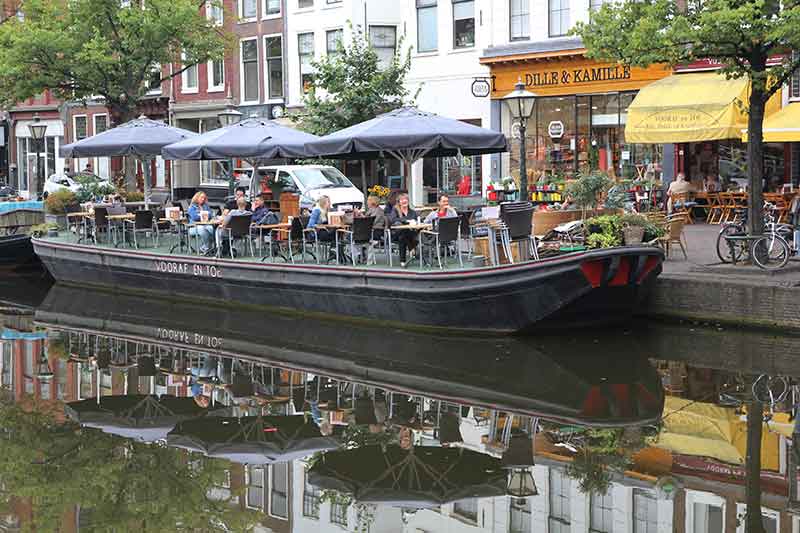
If you see little else in Leiden, be sure to spend some quality time in this lovely central area. Of course Leiden is small enough that there is no problem in seeing most of town in a day with time for shopping and a couple of museums. You will no doubt come back to this lively central area several times.
Even if you don’t feel like doing a lot of walking to explore, just sit at a cafe or on a bench and watch the boats go by, letting the scenery come to you. Many like to call Amsterdam the “Venice of the North” but Leiden deserves honorable mention in that over-used classification, because it almost seems like you’re at a lively canal in Venice. This canal area along the New Rhine (Nieuwe Rijn) near the Grain Bridge is a busy place with all manner of water craft churning along, from little kayaks to larger tour boats and barges. When describing Utrecht elsewhere in the book we extol their canal-side terraces with a view, and here we have a similar picturesque situation.
ff.jpg)
The Beestenmarkt is the largest plaza in the old town with a beautiful harbor in the middle, the Blauwpoortshaven, that has some tour boat traffic and a popular docking spot for little pleasure boats and excursion boats that can take you on a canal cruise. Some boats carry ten people while others are bigger. Six companies offer these boat tours from this harbor and other canal locations in town: Bootjes en Broodjes, www.bootjesenbroodjes.nl; Leiden Canal Cruises, https://leidencanalcruises.nl/; Leiden Water Tours, www.leidenwatertours.nl; Rondvaart Leiden, www.rondvaartleiden.nl; Rederij Rembrandt, www.rederijrembrandt.nl; Stichting De Leidse Rederij, https://www.leidserederij.nl. The last company is operated by 60 volunteer skippers, mostly retirees who enjoy getting out on the water and sharing the experience with visitors.
ff.jpg)
Most of the streets are shared with automobiles, but there are just so many more bicycles than cars that bicycles have the right-of-way. Of course everybody’s familiar with basic rules of the road and is very polite when they’re driving and yield the right-of-way to the bicycles, which also creates peaceful conditions for pedestrians.
ff.jpg)
Step over two blocks to the west side of town to have a look at a beautiful gateway of the old city called Morspoort, part of the medieval fortification protecting town. In the old days a guard was stationed at the gate to prevent attack or trespass, and criminals would have been locked up inside the cupola, which served as a prison. Now it’s all very peaceful, with a beautiful terrace restaurant serving lunch and dinner. The wall was not just decorative and beautiful, it really was necessary for defense of the city. It was especially important back in 1573 with the famous siege of Leiden that went on for one year with the Spanish surrounding and attacking the city until finally driven away by William of Orange, one of the major turning points in the 80-year long war with Spain.
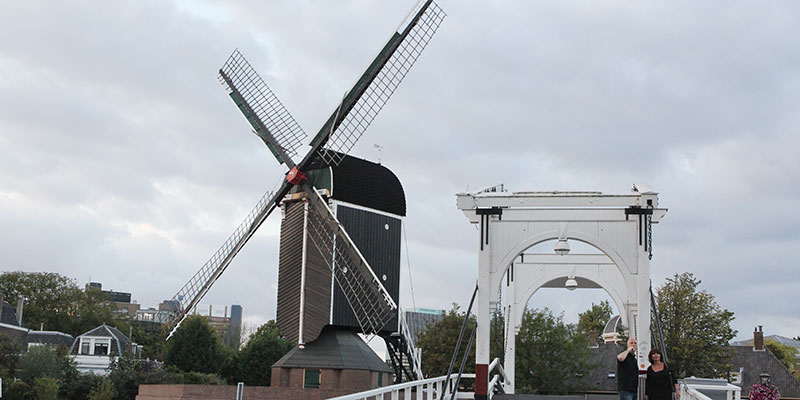
Another historic site nearby is the Rembrandtbrug (Rembrandt Bridge) which is at the location where that famous painter was born in 1606 right here in Leiden. He stayed here for most of his first 20 years in this neighborhood called Weddesteeg, with the windmill nearby which is a reconstruction of what may have been similar to his father’s windmill. It’s called Molen de Put and this one was built in 1987 as a reminder of times past. It’s open to the public, it’s but only on Saturdays.

You can walk out on the Rembrandtbrug at any time and from there you’ll have a lovely view looking back at the Old Rhine canal at a wide point forming a small harbor.
Now let’s jump over to the other side of the old town for a walk along the Oude Vest canal which is lined by more of those elegant old buildings.
Here you’ll find an important art museum, the Museum De Lakenhal with highlights including some paintings by world-famous Leiden masters including Rembrandt and Jan Steen. It has visual arts that illustrate the history of Leiden and the various arts industries here. The building was erected in 1640 as a Guildhall for cloth merchants, one of the most important industries of the city back then. It’s recently undergone an expansion with new exhibit halls and a cafeteria. It’s been an art museum since 1874.
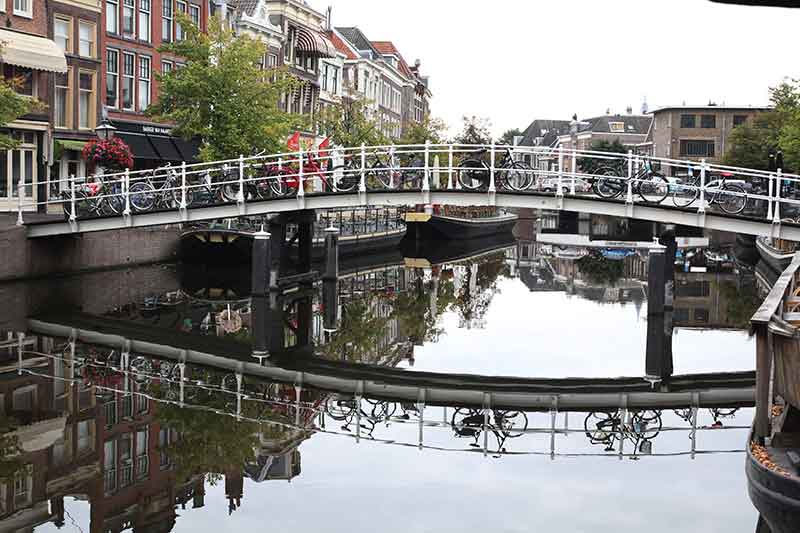
Cross over the canal on a bridge called Marebrug and there you can see a building with red awnings that used to be the bridge keeper’s house. Now it’s a restaurant.
The many bridges of Leiden are another lovely site that you’ll enjoy while walking around. Most Dutch cities have their canals, and bridges, but it does seem that Leiden has way more of them than average, and the second most number of historic buildings after Amsterdam.
This brings us into a residential neighborhood with new housing that’s built in the old style, very tastefully done. While it does have limited access for automobiles, you see there’s no parking areas on the street. It’s mostly for pedestrians and bicycles.
Then arriving at a quiet shopping street, Lange Mare, where you’ll find a hotel, some vacation rentals, restaurants and cafés, on our way to the main pedestrian lane of the city, Haarlemmerstraat, a prime spot for people-watching or grabbing some inexpensive fast food
ff.jpg)
This is Leiden’s big shopping street with a broad range of clothing, toys, shoes, jewelry, electronic sportswear shops – mostly for locals, along with some souvenir stores and in addition to big brands, you’ll find little specialty shops, and leather, and children’s fashions, and many cafés along the way. With so many eateries, ranging from fast food to Italian and Turkish, this is a great place to have a casual lunch.
Haarlemmerstraat is the only major pedestrian lane in town, but you still want to be careful and watch out for the bicycle, bike carts and roller skaters going by.
One of the traditional Dutch elements that you find here is the hofjes. This is the traditional housing for senior citizens. You find these garden apartments throughout the country, with a history that goes back hundreds of years. One home here was founded in 1487 and is named after the saint of the beer industry, St. Stephen.
Next, we’re going across the canal to the Burcht fort, then we’ll continue on to the University neighborhood and back to the center where we opened the chapter. No matter where you walk, you’re always near another beautiful canal.
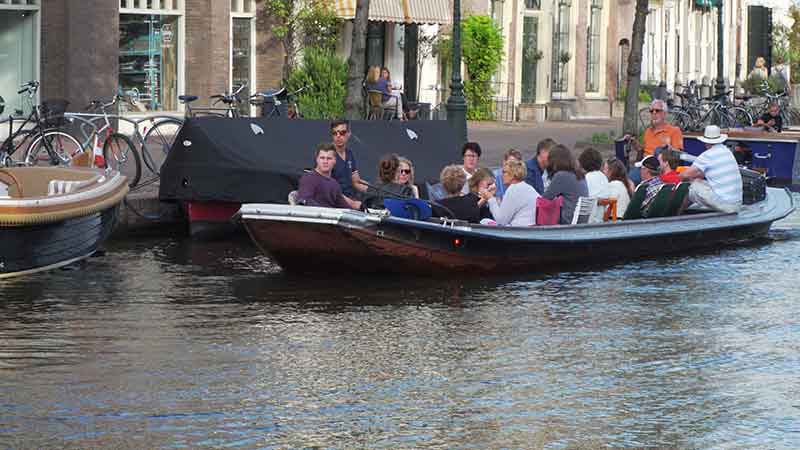
The ornamental gate with two towers straddling the arched entry at the end of this lane is quite special. You’ll see a lion on top with a sword in his hand. This leads into the fortress.
It’s the Burcht, the Citadel of Leiden, up on a man-made hill overlooking the city, located next to the New Rhine canal. The Burcht seems highly visible up on the hill, but when you’re at street level, it kind of disappears, hiding in plain sight.
ff.jpg)
Perhaps the oldest structure in town, it’s a fortress that started as early as the ninth century as a hill of turf and clay, and developed over time into this solid brick fortress, 20 meters high, providing defenders a fortified bastion with an excellent view.
It’s certainly worth finding and walking up the staircase to get into the castle. The Citadel is open all day long and into the evening with no admission charge, so you’re welcome to enter and walk around and climb up on the ramparts. It’s up on an artificial hill called a motte that was created during the late ninth century, with brick walls added later. It’s a typical motte-and-bailey type construction with the circular fortress on top, one of the oldest examples of such castles still in existence in the Netherlands.
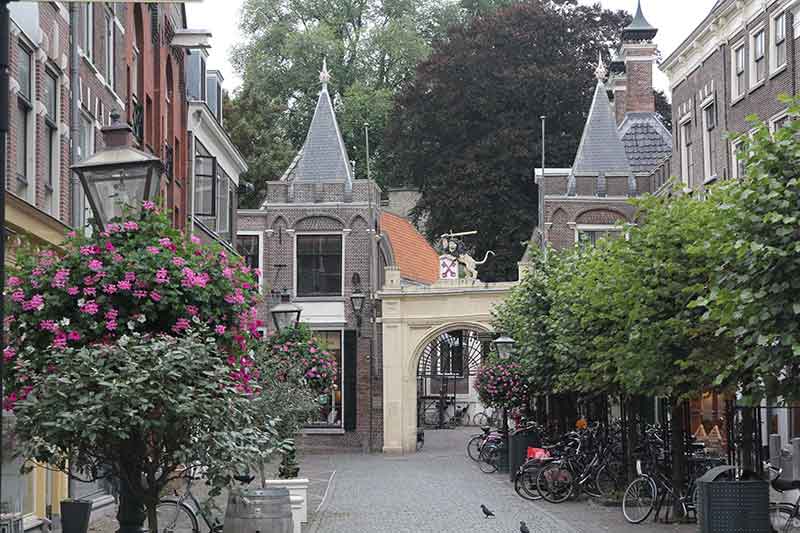
From the fortress you get a fine view of Hooglandse Kerk, one of the largest and most important of town. Originally the Burcht was a defensive fortress situated in a strategic spot where the two arms of the Rhine merged together, also, making it a good place from which to inspect the shipping going by. It’s a prominent location on the highest point in the old town, and yet, it’s surprisingly difficult to find it nowadays with so many 18th-century buildings clustered all around it, but keep looking. It’s worth discovery because of the fantastic hill, the castle and the viewpoint.
Walk a block to cross over a bridge to the other side of the New Rhine Canal, passing through the City Hall with their open terrace courtyard cafe. Come around to the front side of the City Hall to admire its façade that was designed in the late 16th century, and rebuilt after a disastrous fire in 1929.
.jpg)
City Hall is located along the very busy Breestraat, a broad shopping and transportation street. It’s limited to bicycles and buses for most of the day, with local and intercity bus routes, such as to the Haag, which you can reach in about 45 minutes, with a generous sidewalk for pedestrians and many shops, restaurants and cafés, making this probably the busiest street in the city, especially with its proximity to the University, where we’re going next.
In the Middle Ages this street was already one of the most important residential centers. It remains so today with shops at the ground level and apartments upstairs.
The Concert Hall is an impressive example of Neo-Renaissance architecture that is rarely found in the Netherlands. Leiden has had a concert hall for more than two centuries. Construction on this one was completed in 1891.
We’ll get to nearby Leiden University in a moment, but there are several other smaller colleges, some industrial, some trade, some technical schools and there is a university medical center and the school for vocational education located in the heart of the historic center. Altogether there are about 35,000 college students in the city.
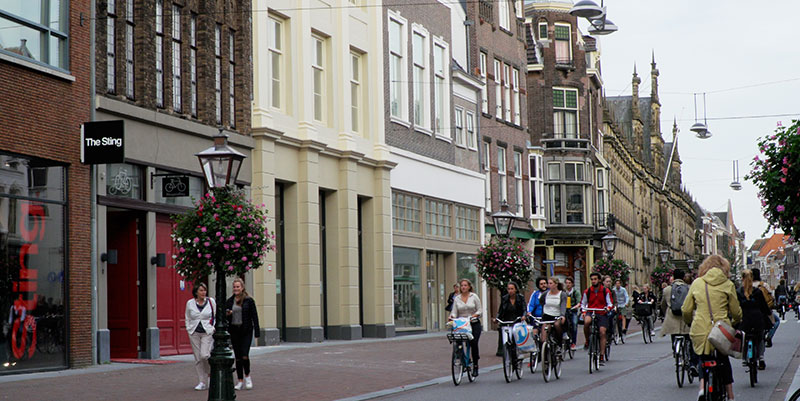
Although it does not run alongside any canals, Breestraat is still a very attractive street to experience, especially because of the lack of cars. So this is a place for people, with many practical shops and places to eat and drink. Yet perhaps the best attraction are the little lanes that lead away from it heading over towards the University of Leiden, which bring you into a small-town village atmosphere with a somewhat bohemian character.
The neighborhood is called Peter’s Quarter because it’s all around the church of St. Peter with many little lanes for pedestrians lined with shops and cafés. To recap, we walked in ten minutes from the Burcht over to City Hall and into the Peter’s Quarter, after which we shall take a little wander over towards the University.
.jpg)
This Peter’s Quarter section is only a few small blocks but if you are lured to meander up and down many of the lanes because of the attractive shops, you’d be walking over a kilometer. You might enjoy browsing around here for a couple of hours.
We’re talking about the neighborhood between the new Rhine and the Rapenburg canal. It’s a little bit off the beaten track for most tourists who come to Leiden, but there are some historic structures that will lure the visitor in to have a look around this sector of town. So when you come over be sure to check out those little alleys, and also the historic sites like Peterskerk (Peter’s Church), Gravensteen Prison, the Latin School and a few other sites, but mostly it’s the historic overall character of this neighborhood, which is one of the oldest parts of Leiden.

Peterskerk is the namesake of this Peter’s Quarter neighborhood which is also sometimes referred to as the Latin Quarter because of the Latin language used for early schooling in the area. It’s believed the city’s name, Leiden was derived from the Latin word Lugdunum, and there is evidence of ancient Roman settlements.
The big church is late Gothic dating back to 1390, but in the 1970s it was deconsecrated and converted into a museum and event space, sometimes open to the public.
Leiden’s history goes back a long, long way. People have lived on the banks of the Rhine for millennia. Around the year 1200 the settlement had developed such that the Count of Holland offered city rights to the inhabitants, and the city of Leiden was born.
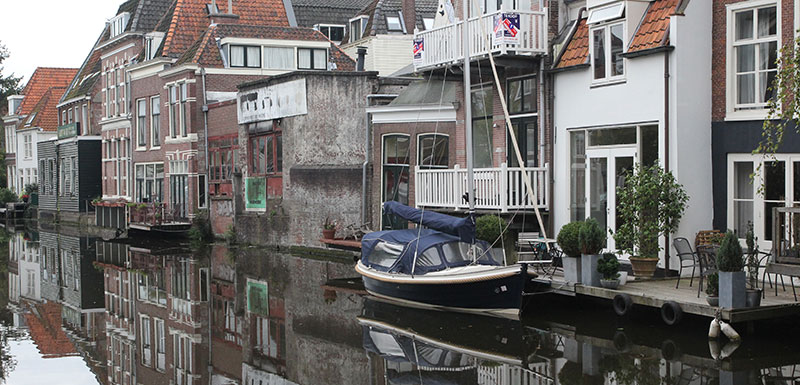
At the end of the 15th century Leiden was the largest city of the County of Holland, mostly thanks to the international clothmaking industry, which was their main trade, and that prosperity is reflected in buildings such as Peterskerk.
Getting closer to the University campus you’ll notice more students out and about on the roads. You might run into one of those many special times of the year when some students are graduating, which means it’s time to have a little party, or a big one -- there are 30,000 students.
.jpg)
There is a perfectly beautiful outdoor restaurant conveniently located just across the canal from the University, Café Barrera, which makes a great place to sit down and enjoy life with your friends and celebrate your new diploma. Crossing the Rapenburg canal, we are entering the campus of the University of Leiden.
It’s the oldest college in the country, founded in 1575 by Prince William of Orange, who famously gave the people of Leiden a choice after the victory over the Spanish: they could either have a reduction in their taxes or they could have a free university. They chose the university.
.jpg)
Right away we see its most impressive building the Academy Building, which dates back to the 1580s. Each faculty department has its own room here and it’s the location of all important ceremonies, especially graduations. The university began in this building, which started out as a chapel of a former Dominican convent. Then the nuns left the convent after the Reformation, and the building was empty, so the University took it over and expanded it.
The Hortus Botanicus is part of the University of Leiden and it’s the oldest botanical garden in Western Europe, aside from a couple of gardens in Italy. It was founded in 1590, and it’s been accessible to the public from the beginning. You’ll find that it’s a delightful place to stroll. We had a little chat with a professor who does some research here and also serves as a guide to tell the public about the gardens.
.jpg)
“Hi my name is Jan Hengstmengel. I’m a biologist and am working here for more than 20 years now guiding people through this botanical garden. Our main research subject is the family of orchids. It’s a huge one of 35,000 different species. Our collection of living ones is about 6000. Also, the garden played a role in the tulip phenomenon. Flowers became important to the economy, so this garden played a big role in the economy in that way. Since some centuries we’ve called the Netherlands the “tulip land of the world”, and now it is still an important economic factor, I mean there are hundreds of millions of euros running in this business. “And the first Dutch tulips were planted in this garden, eventually creating a big economic boom that’s continued to this day, but not many tulips in the garden now. To see them you want to go out to the fields nearby Keukenhof, the famous tulip fields, especially in late April, early May.”
Here they’ve got some greenhouses that you can walk into during your visit, and there are several different ethnic gardens, like the Chinese herb garden and a Japanese pebble garden for a little Zen meditation. It’s a reminder of how the Dutch were able to set up a very successful trade deal with the Japanese back in 1609, the only westerners allowed into that closed society.
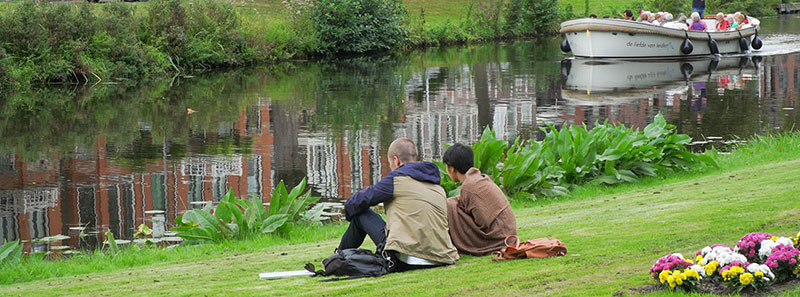
An especially delightful part of the garden is the stretch along the Singel canal where you have the lawn and flower beds, and almost a picnic ground. It’s one of the nicest canal-side environments in the entire city. And you can only see it if you’ve paid the small entry fee or from a canal boat tour, but nicer inside the garden. This view alone makes the entry price worthwhile.
While we enjoy some final moments of peace and beauty and tranquility in the garden, let’s listen to some thoughts from the mayor of Leiden, as published in a brochure conveyed to us by the Leiden Tourist Information Office, a very helpful source of information about visiting Leiden:

The mayor’s message says, “The international reputation Leiden enjoys is a city of knowledge is one of monumental renown and a long history. New discoveries are still made in our city every day at the University at the lives University Medical Center and at the bioscience Park which is developed into one of the world’s strongest biomedical science clusters.
The mayor concludes, “Leiden boasts many attractive features as a city rich in cultural heritage of vast wealth of history and art and science and a beautiful vibrant city center where almost everything is within walking distance”.
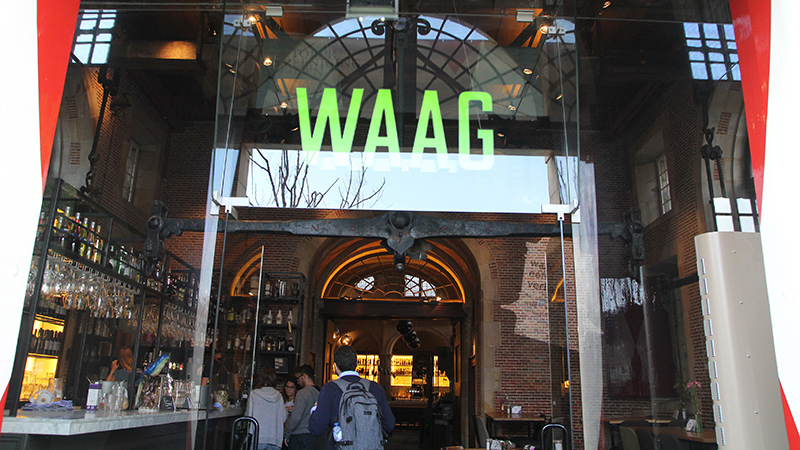
Now walk back to the New Rhine canal, just 800 meters away, about five minutes away, where the Old Rhine and New Rhine canals come together at the Water Square. This is the nicest neighborhood of town, where you have several cafés with lovely views of the canals, and the Waag, which is the old weighing house and now it’s a popular bar. From the mid-17th century it was a place where merchants came to weigh and trade a variety of goods.
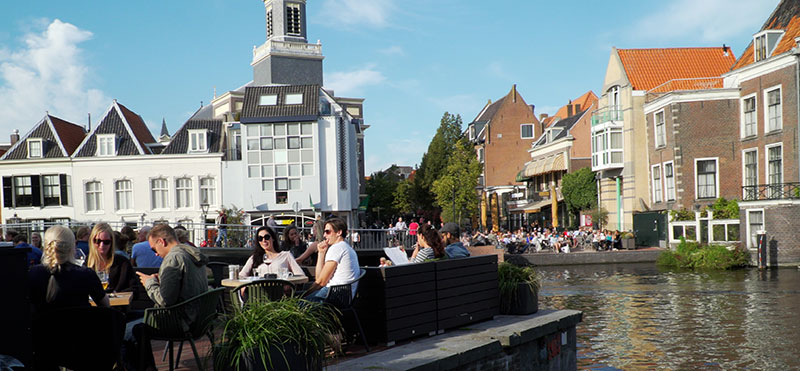
This is the epicenter of town where the canals come together, the terrace cafés look out at each other, and people are here for a good time. If you only came to Leiden for two hours, this is the place you want to come, but you’ve seen already, there is so much more of this city to enjoy. It’s worth spending one or maybe two nights.
If you’re there on a Sunday the town is pretty quiet but there is a fabric market going on alongside the main canals, although it’s kind of ironic and a little bit sad that Leiden, which had been a major manufacturer of fabrics back in the 17th, 18th, 19th centuries, doesn’t make fabric any longer. It all is imported from other countries.
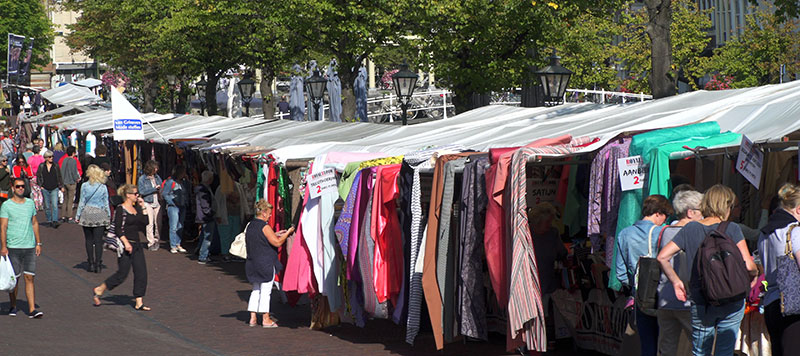
That’s the way goes in the modern world, but the fabric market is a popular place to be. If you’re there on a Saturday there is a much bigger market, a typical street market with mostly vegetables, produce, clothing, antiques, all sorts of things happening on Saturdays, and a smaller street market on Wednesdays.
There is an advantage to being in Leiden when there’s no market going on, because the town is a bit less crowded so you can enjoy the streets, lanes, shops, restaurants and museums without so many people around.
It takes just five minutes to walk to the Museum of Ethnography, for a look at cultures around the world. And then we’ll continue on to the Museum of Antiquities with its display of archaeological treasures.
Leiden is home to the Museum Folkenkunde, or in English, the National Museum of Ethnology. It’s a culture history museum’s featuring artifacts and presentations from many countries around the world. It can be considered the first ethnographic museum in Europe because it was the first one that displayed artifacts as more than just curiosities. From its earliest beginnings in 1816, it was designed to conduct scientific research and educate the public, using the artifacts to illustrate basic cultural principles.
.jpg)
They have a large collection of items from native America from the plains up to the Arctic, and Asia and the Pacific. The museum developed a dramatic and innovative way to present information about the cultures using projections on the wall of video and still images, turning what had been large empty, boring, blank walls into vibrant displays of a living culture. The sensitive way in which objects are presented elevates them from mere daily artifacts to true works of art.
.jpg)
After enjoying the large room of North American objects you’ll move to the Pacific Island collection with a stunning number of images from New Guinea, with carved and painted ancestral gods.
Polynesia is also represented with some young Tahitian dancers and carved objects from throughout the Polynesian triangle including these Maori figures with carved tattoos from New Zealand, and a variety of fascinating fishhooks.
.jpg)
Some eerie skeletons backed up by another video projection celebrate Mexico’s Day of the Dead, and you’ll see native fabrics, ceramic items and valuable pottery from Central America.
The museum’s first major acquisitions were 5000 items from Japan that were collected in the 1830s at a time when the Dutch were the only Europeans allowed inside Japan, making these items unique and extremely valuable. You might recall that Japan closed itself off to the outside world from the 17th through the mid-19th centuries. During those years of isolation the Netherlands was the only European country that was allowed to maintain an active trading agreement, operated by the Dutch East India Company for 200 years, based in this village in Nagasaki.
.jpg)
A friendly museum visitor was telling his young son about this, so I asked him if we could listen in. He explained, “The Japanese Emperor decided to expel foreigners because there was too much Western influence, from the Dutch and Portuguese. The Portuguese protested, they didn’t want to leave, but they got kicked out. The Dutch trader didn’t want to fight the Japanese, and he decided, okay well if they want us to leave, let’s go. Let me dismantle everything. I’m not leaving them one nail.
“Because he dismantled everything, and the Emperor heard that, he said ‘this is a guy who really follows my orders’. Another advisor of the Emperor said ‘maybe it’s not such a good idea to completely isolate ourselves. Let’s leave one channel of communication open for to the outside world’.
“So the emperor invited the Dutch back and gave them this artificial islands on the coast of Nagasaki, which was originally constructed for the Portuguese, and gave them effectively a monopoly. He was very interested in the guns and cannons. They made good money on cannons. And the Dutch took the ceramics. Yes ceramics and all kinds of other goods, precious metals, whatever.” “Hhow do you know so much about that?” “That’s History Channel.” Okay, thank you sir.
.jpg)
The Chinese collection got started way back in the early 1800s by King William I who founded his Royal Cabinet of Curiosities with some of these Chinese items that were later added to the main ethnographic collection. The museum moved to its present location in 1937, which underwent major expansion in the 1990s and now it is joined with two other Dutch museums to form the national Museum of World Cultures with a total collection of nearly half a million items, including the famous Benin bronzes from Africa.
The museum also has some fun with contemporary and innovative temporary displays that challenge your mind. This is not a museum that’s only for displaying objects. It’s an active research museum involved with cultures of the past and today. The museum’s stated mission is to awaken our curiosity about the enormous cultural diversity that enriches the world in which we are all linked together, to increase the understanding of these mutual bonds, which allows us to inspire an open attitude to the world and help to shape a global community.
The final stop on our walking tour, before joining the canal boat tour, is taking another pleasant walk along the canals another 800 meters to the Museum of Antiquities, a fine archaeological collection with major holdings in five permanent exhibitions featuring the Roman, Greek, Etruscan, Egyptian and Near East. Honoring the host nation, there is an exhibit on Dutch civilizations and more. The collection of this museum began with an inheritance of about 150 antiquities that was bequeathed to Leiden University back in 1743 when it was placed on public display. The collection grew with further purchases and in the early 19th century, the museum led various expeditions to do archaeology in the Mediterranean area.
2up.jpg)
First thing you see upon entering the lobby is an Egyptian temple, which was going to be submerged under the Nile waters because of construction of the Aswan High Dam. Because the Netherlands played a role in the rescue operation, the Egyptians showed their gratitude by giving this temple to the Dutch people. We will see more of Egypt in the upstairs galleries.
There’s an impressive collection of Roman statues carved in marble and a lot of jewelry, and household artifacts as well as glassware. Ancient Rome did occupy the southern Netherlands up to the Rhine River placing Leiden right at the frontier, where the Romans built a fortification protecting them from the barbaric Germanic tribes on the other side.
.jpg)
The large array of Etruscan tombs is a highlight of the collection. Ancient Greek statues date from the archaic, into the classical, through the Hellenistic periods when lifelike poses seem to be in motion, including some gilded bronze.
Poignant Greek sculptures commemorating the dead still arouse sorrow, with realistic tombstone carvings of mourners bidding farewell to the beloved departed. Among many other Greek treasures are dozens of vases from Mycaene and Corinth depicting mythological and daily life in their painted figures. From Mesopotamia we have the world’s oldest form of writing.
.jpg)
A realistic model of an ancient Roman house from Pompeii with an atrium and open courtyard helps you imagine the opulent ancient life, but the red tiles couldn’t protect it from the eruption of Mount Vesuvius.
A large part of this collection consists of objects covering 2000 years of the ancient history of Egypt: statues, along with jewelry, mummies and sarcophagi, and funeral objects depicting daily life. The mummification process is dramatically displayed with colorful sarcophogi, wrapped mummies and canopic jars used in that burial process.
.jpg)
This comprehensive collection also reaches much further back in time, into the Stone Age, where we see the crudely chipped and finely polished stone tools.
You will discover there is something for everybody to enjoy here in one of Europe’s best museums of antiquity.
While it is rewarding to look at these objects on display, you’ve also seen the city, itself, is like an outdoor museum with beauty all around.
GET LOST
Now that we have covered the basic walking routes and historic sights, with our boat tour coming next, this is a good time to just toss the map aside, ditch your tour guide, take a long walk and get lost.
With charming streets like this, you would enjoy a random ramble, the aimless wander from one part of town to another, like flaneurs of old, out for a stroll, observing details yet not thinking much about them, free to go wherever, enjoy reflections, shop, eat, drink, appreciate the historic, stroll along canals but watch your step — no railings, visual distractions, uneven brick paving, but most enjoyable. The endless charm of this city offers a good reason to spend at least two nights here, or maybe three.

To make the most of your valuable time here, you’ll find it is worth getting up early for the sunrise when you’re staying in a city like Leiden. It’s usually not too windy at that time of day, so pretty, colorful, peaceful and with so many tranquil canals you’ll see some lovely reflections, something most people would simply sleep through, but they are missing the golden opportunity.
In many other cities that you will visit there is nothing to see at sunrise. You might be staying in a hotel surrounded by big buildings where you can’t e ven see the horizon. So don’t bother getting up early in that case, but in cities in the Netherlands with all those canals, you’re likely to find a beautiful sunrise.
The canal boat tour is a perfect way to get an overview of the city while sitting and relaxing for an hour watching the historic buildings glide by. They say Leiden has more canals than any other Dutch city besides Amsterdam. They extend for 28 kilometers within the inner-city and are crossed by 88 bridges, some of which are quite low so keep your head down when you go beneath them.

There are several different boat companies to pick from, all of them offering the same basic canal route in a variety of size and style of boat’s, with most of them departing from the Blauwpoortshaven at the Beestenmarkt. Most boats are open-air without any roof or windows to block your view. That works perfectly during the seasons when Leiden has a mild climate. However, in the winter they usually do not run and sometimes the canals freeze over, so there is no boat traffic. One special boat tour company relies on 60 volunteers to do most of the driving and guiding – a lot of retirees and other interested residents of Leiden who pitch in and help out. They have 12 boats and are located on the Rhine canal, just around the corner from the main harbor.
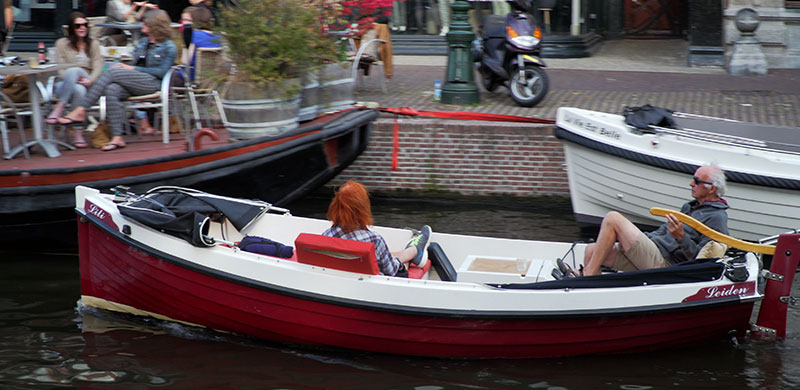
There are lots of boats cruising around with groups on board, but not all of them are tours. A lot of them are just bunches of friends, people out for a cruise. It’s a major recreation here throughout the Netherlands. And if you want you could rent your own boat, or you could rent a kayak and just go paddle at your own pace. Maybe go fishing while boating. The water is surprisingly clean.
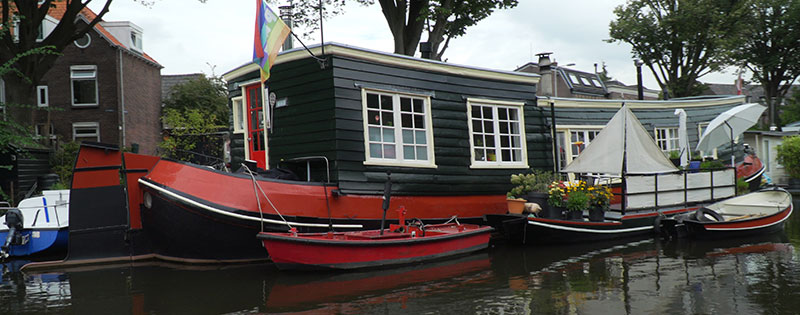
The first site is a series of houseboats, some of them older than a 100 years, and people live here permanently. They were ex-working ships before. They have to remain seaworthy, so once a year they go for a little round and then they come back here for another year. Then you’ll pass the Rembrandt Bridge, seen earlier on our walking tour.
Now we are leaving the River Rhine and turn left to the Singel of Leide. A big beautiful building here was a school for sailor men. But in fact was it a place for all the bad boys. At the University library there are many bikes are standing in front of the building, showing many students are inside. We don’t know if they’re really studying, but they are at least inside. Some people say the canals are 3 meters deep: one meter muck, one meter bicycles, and just one meter water.
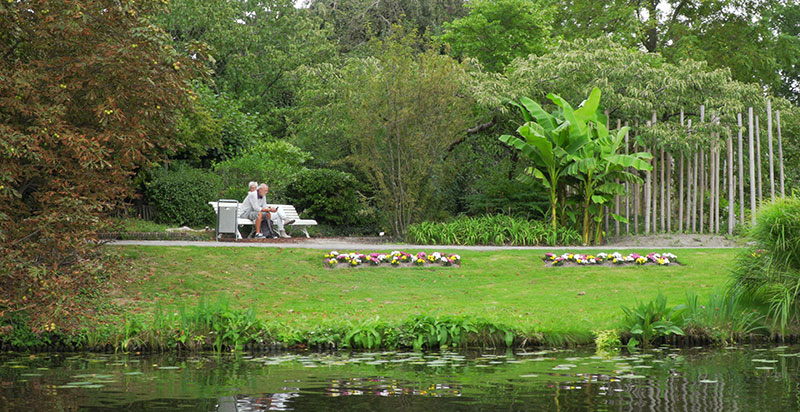
We glide past a canalside park that belongs to the botanical gardens, the Hortus Botanicus we visited earlier in our walk through the university. It’s the oldest plant collection in northern Europe, a lovely place to stroll through, especially this garden setting alongside the canal. Every canal tour boat will pass by to admire the view.
We have been cruising along the Singel, which is the outer canal that surrounds the old town, originally dug in the 17th century to protect the city like a moat, the equivalent of a medieval wall.
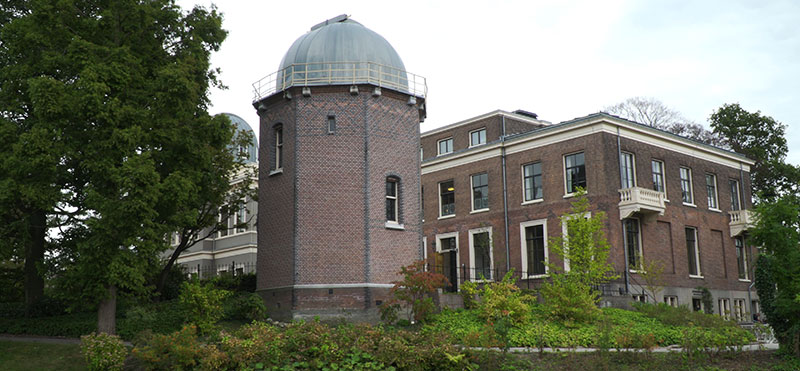
Up next is the world’s oldest university observatory. When the sky is clear then you can see those telescopes turning, everything is still working, but today they are not used by professionals, only by amateurs. The reason is that Leiden has too many lights into the sky so you cannot see all the stars and planets.
And next we turn into the Vliet Canal, sometimes called the River Vliet. It’s a small portion of a longer canal that goes all the way to Delft, and it was very famous in history because this is where the Pilgrims left Holland to go to the Americas. Did you know that President Obama has an ancestor who was among those pilgrims from Leiden? Well it’s another pretty canal and you might sometimes notice green algae floating on the surface. It comes in seasonal blooms affecting many of the canals of the Netherlands.
Next, we cruise along on the Rapenburg canal that was the city’s most prestigious back in the 17th century. Coming up on a peaceful green park that’s the result of a disaster. In 1807, a ship full of gunpowder blew up here and killed nearly 200 people, destroying many buildings here and throughout the city. And it was later redeveloped into this memorial park with a statue of Mayor Van der Werf in the middle, who was a military hero back in the late 16th century and the battles against the Spanish.
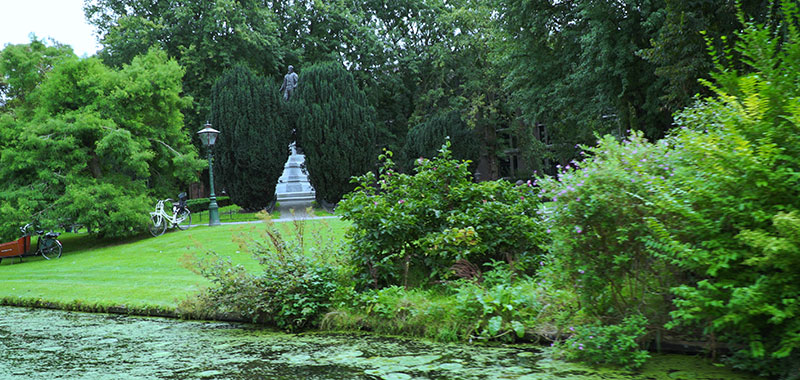
That war in the 1570s was a defining moment in the history of Leiden. It was the Dutch rebellion against the Spanish occupation at the hands of Philip the Second. Leiden was surrounded and besieged for an entire year by the Spanish, who were trying to starve the people into submission. And the Dutch came to the rescue by flooding the fields all around Leiden so that they could sail their fleet of warships and defeat the Spanish under the leadership of the Dutch king, William of Orange.
Now heading into one of the major canals of the city, Herengracht, a place where the nobles and rich families lived back in the 1700s, first dug in 1659. While cruising along the guide is always pointing out some of the historical features, including a most unusual retirement home, which was a place for old couples. If you were still happy and together then you didn’t want to come here because the wife goes to the left side of the building, and husband to the right side with a yellow line separating them, and only at breakfast you can see each other. Today there are students living inside and they’re all mixed together, not the women on the left side, the men on the right side.
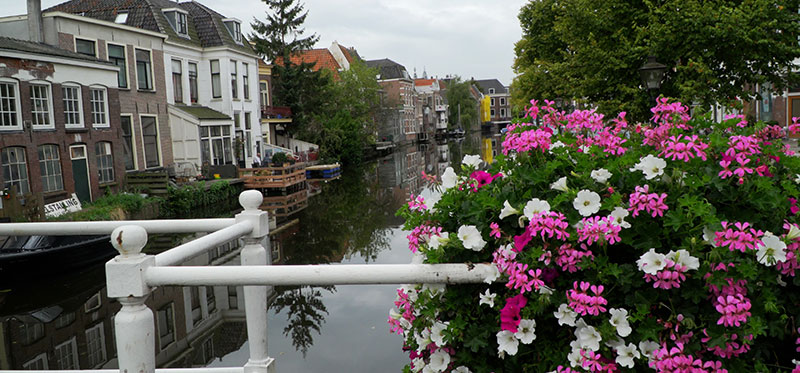
Leiden’s bridges provide endless visual delights, each one of them different than the next, mostly made of brick but sometimes metal or wood. Flowerpots on top add a nice gesture to many of these crossings, which boast a variety of railings to protect travelers, especially helpful at night for those having a few rounds at the local pub, or for clumsy tourists stumbling over irregular pavement. But be advised, most canals are not lined with railings, so be careful while walking along distracted by the sights, looking more at a camera than your footing.
Some buildings have little windows in the old-fashioned style where they tried to avoid the tax on big windows. Of course, most of the buildings that we see along the canals are residences in structures that date back hundreds of years. There also a lot of houseboats in the canals of Leiden. Coming up now we will see a long stretch with dozens of houseboats.
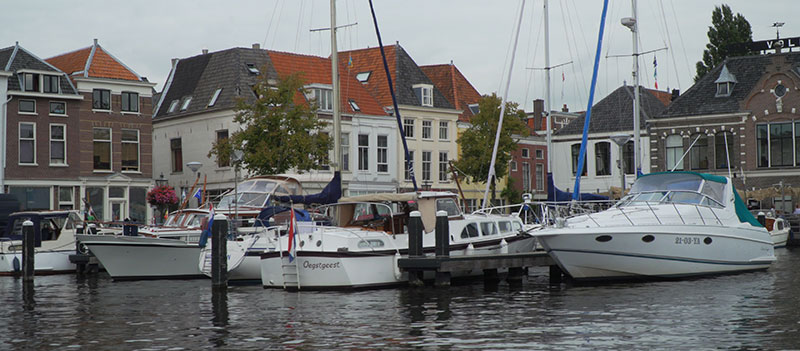
Passing another bridge, we are leaving the Herengracht canal and entering a broad section of the Old Rhine canal with marinas. This wide canal section is in a place where several waterways come together and form a marina, which would’ve been a small harbor in the old days where bigger ships from the intercity canals would stop and offload their cargo to smaller ships that would go through the little canals of the inner-city. Now we are re-entering the big Singel canal that goes all the way around the old city. It forms a major intersection with the Old Rhine as well. And here we find collection of interesting historic sites.
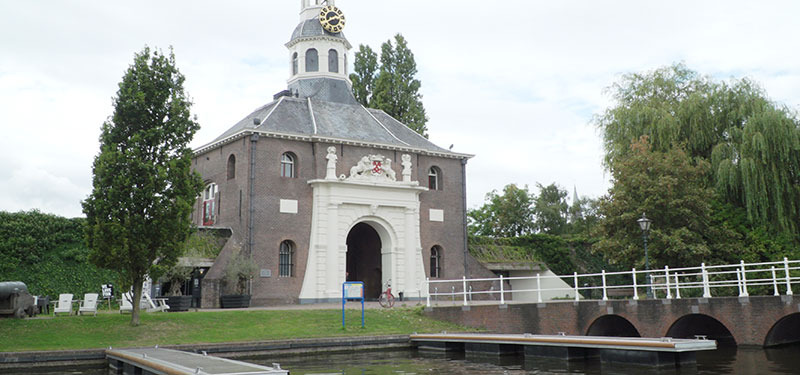
Most impressive is the Zijlpoort. It’s one of the eight original gates that led into the city through the medieval walls. Now there are just two of these gates remaining. It was built in 1671 in classical style by a local architect. Next to it on the big canal is your typical drawbridge that can be opened for larger ships going through, and some historic cannons. After all, this was part of the fortifications of the city. The Dutch were very proud of the high quality of their cannons.
Now we’re coming to that stretch of canal with some working ships, some of which are hauling cargo along the rivers of the Netherlands and perhaps all the way down the Rhine into Germany, and many houseboats for living on board while permanently docked.
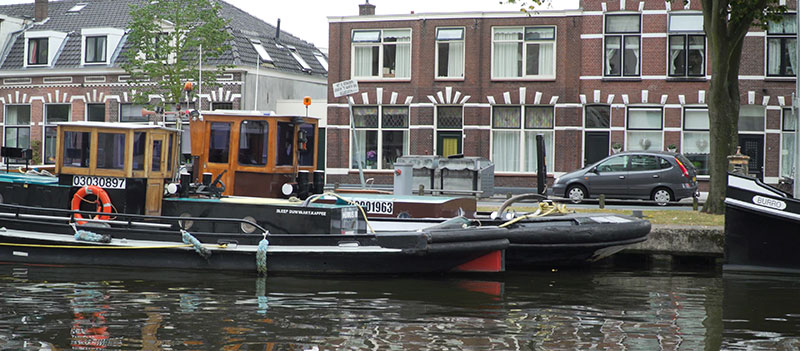
In olden days canals formed the chief roadways of the country and the main streets of the towns; instead of heavy carts and straining horses there were broad-beamed barges and brown sails, an easy way to travel and move cargo.
But why so many canals you might wonder? Well the Dutch were forced by necessity to construct canals, with so much of their nation below sea level. As fast as they tried to make roads, the stones or bricks sank into the mud and left things soggy and boggy. So with their usual enterprise they started upon canals, and have not ceased constructing them for nine hundred years. With their thousands of windmills they pumped water out of the marsh and into the canals forming farmland and waterways.

The Netherlands is a country of canals. It may have cities, roads, trains, farms and quaint buildings, but it is a country of canals before all. The canals set the tune and make this nation unique on Earth. Nearly all the Dutch towns are amphibious, but some are more watery than others, especially Leiden.
For the new visitor it is quite unusual but after a while one gets accustomed to the ever-present canal and the odd spectacle of watery streets. These canals are of all depths and widths, from narrow ditches running at the side of the road, crossing fields and gardens all the way up to the North Sea. By means of this grand network of waterways nearly every town became a port, every village could communicate with the sea.
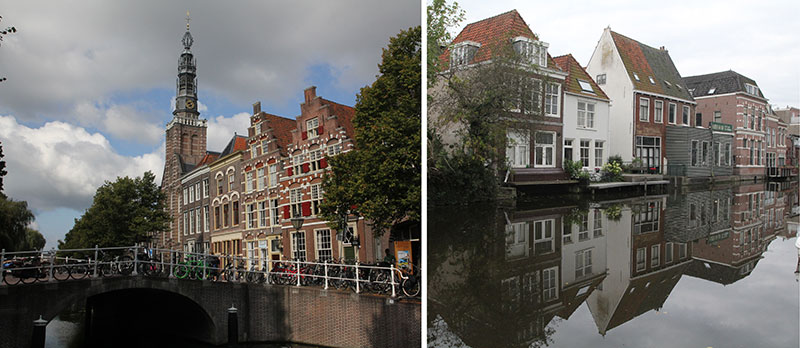
Altogether, the canals in Netherlands combine to make the waterways of Venice look like a little puddle.
We are almost done with our journey, reaching the confluence of canals at the town center where the New Rhine and the Old Rhine come together here at the Water Square. As we saw in our walking tour, this is a great place to hang out – one of the most popular spots in town for the canal café terraces. You’ll find a few hotels in the center, for example, one of the old city hotels of Leiden, the New Minerva, consisting of five historic buildings joined together.
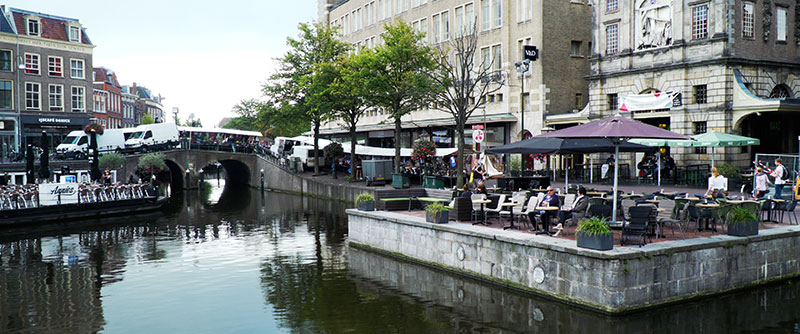
Now you know almost everything you need for a successful visit to Leiden.